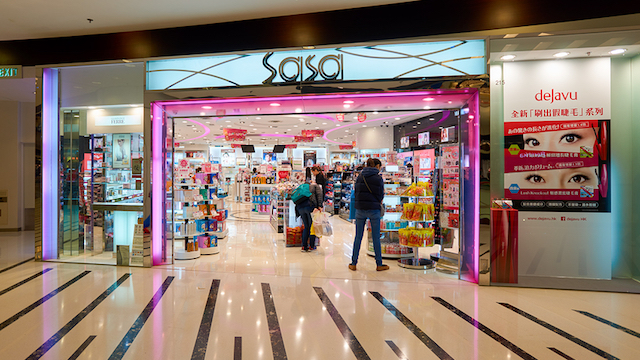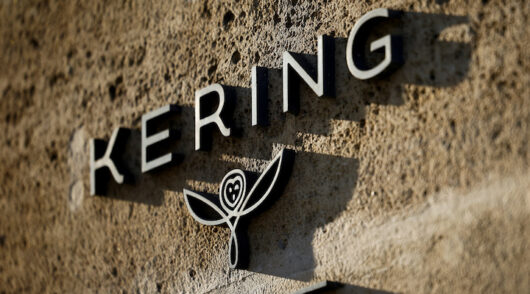Sasa Singapore sales slumped nearly 10 per cent last financial year, with the Hong Kong-headquartered beauty retailer blaming internal management issues for the decline.
Singapore sales totalled HK200.7 million (S$35.6 million) according to full-year financial results released this week.
Same-store Sasa Singapore sales dropped by 7.6 per cent in local currency.
“The group’s performance in Singapore was affected by the high turnover rate in the management team. This has made it difficult to build the requisite knowledge bank, and therefore has reduced management’s effectiveness in a difficult market environment.
The group restructured the management team in Singapore in the first half of the financial year, allocating higher performing management resources from Malaysia to assist Singapore operations. This has helped to control costs and improve management effectiveness.”
Sasa International says its total retail space in the city has continued to increase over the last two years, diluting foot traffic to existing stores and leading to a decrease in turnover.
“The decrease in gross profit was also caused by deleveraging as a result of sales contraction, and a decline in the sales of house brand products. The decrease in sales narrowed in the second half as compared to the first half of the financial year.”
The group also rationalised the store portfolio during the year. These initiatives helped to improve same-store sales performance significantly in the second half of the financial year.
Product offerings were aligned with the latest market demand, and the group’s digital presence was strengthened due to changes in the product mix. However, a significantly lower gross profit percentage as a result of these product mix changes impacted store level contribution.
Overall figures
Squeezed margins ate into Sasa International’s group profits during the year, with profit slumping 14.8 per cent to HK$326.7 million, despite a decrease in turnover of just 0.6 per cent to $7.746 billion.
But Sasa has reported rising sales and basket size in the last two quarters of the year and expects savings from renegotiated rents to begin to impact on the group’s bottom line this current year.
The company blamed the decline in group-wide sales on a decline in Mainland tourist arrivals in Hong Kong, a weaker renminbi and changing consumer preferences, as well as the growing preference of Hong Kong residents for outbound travel.
“Keener online and offline competition and the evolving nature of the customer journey also played their part.”
Sasa said it arrested the decline by adjusting its product range to meet changing consumer preferences. The group added lower-priced, trendy Asian products to its offer and expedited product-purchasing procedures.
“The time required for product launch was reduced through flexible and effective sourcing procedures. The optimisation of product mix and improved product display also helped to realise the potential of product sales.
Gross profit margin decreased from 43.2 per cent to 41.5 per cent.
House brands falter
Meanwhile, the rapid change in consumer preferences led to a decrease in house brand sales mix from 41.9 per cent to 38.5 per cent.
“Efforts to drive sales in a slower market by launching a continuous program of promotions also contributed to a lower gross profit margin. Actions have been taken to tackle the decreased gross profit in this financial year, with the percentage decrease slowly narrowing,” the company said.
Now it is focusing on expanding its own-label portfolio and launching new lower-price own brands to raise consumers’ purchasing desire.
“Stringent cost controls” have helped alleviate the pressure on profit. Expenses ranging from shop expenses to administrative expenses all decreased, partially offsetting some of the negative impact of a weaker gross profit margin.
During the year, the group relocated certain shops, which while resulting in duplicated rentals after opening nearby stores in better locations during the transitional period, will result in lower rent overheads from this year onwards.
“If the group had not taken advantage of a weaker rental market to improve the positioning of its stores, the result of rental costs’ control would have been more pronounced. As the rental adjustment cycle continues, market rentals are expected to progressively decrease.”
Malaysia withstands challenges
Sasa International’s turnover in Malaysia was HK$332.1 million, an increase of 12.4 per cent in local-currency terms, while same-store sales increased 6.2 per cent.
“The fundamentals of the group’s business in Malaysia are strong. Driven by a robust retail network and effective marketing campaigns, the group’s sales performance in Malaysia outperformed its competitors and the overall retail market.
“However, due to a high base factor in the previous financial year, a faltering economy, declining consumer spending power, and the allocation of some management resources to Singapore, sales performance in the second half of the year was weaker – although performing better than the overall market.”






